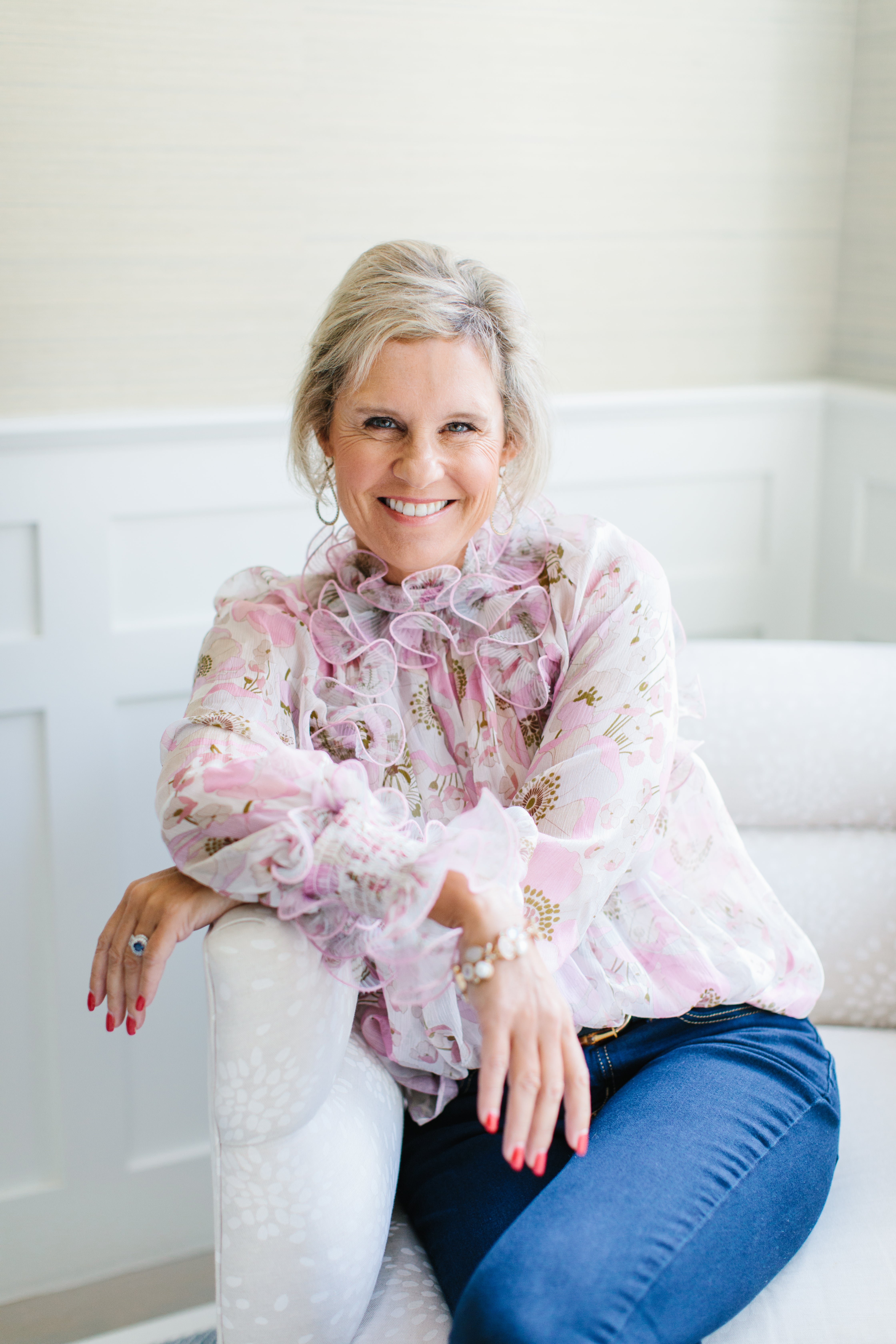The 50 States Project is a yearlong series of candid conversations with interior designers, state by state, about how they’ve built their businesses. Today, we’re chatting with Newport, Rhode Island–based Jocelyn Chiappone of Digs Design Company about how her sales background helped launch her design business, why she’s so devoted to mentoring her staff, and what it’s like working in a summer vacation destination.
When did you know that you wanted to be a designer?
I always had a creative side, but I went to University of Vermont and was a marketing major and art history minor, and my first career was in sales. I worked for the Eastman Kodak Company in New York City. When I moved to Rhode Island and had my family, I redecorated my own home, and friends started to ask me, “Hey, can you help me out with my place?” I thought, I should really make a career out of this. So with three kids—one was only a 3-month-old—I decided to put myself into design school. I made it through, worked for another firm for seven years, and then ended up going out on my own.
That sales and marketing background had to come in handy along the way.
I feel like the design is intuitive, but the training that I had in sales for a Fortune 500 company has definitely been the catalyst to our success. You can be a great designer, but if you can’t convey and sell the ideas—I mean, that’s really half the battle.
You worked for another firm, then went out on your own—how did you know it was the right time to leave, and what did those early days look like?
I actually look back and I wish I had left earlier! But I was going through a divorce at the time—I had three kids and school, and it was hard to make that leap into not having a steady paycheck every week. I started out in my spare bedroom and had a part-time employee who came in a few days a week. One Christmas, when I looked in my dining room, it was covered with 20 UPS boxes—that’s when I said, “OK, I gotta move.” So we found a great little place in Newport for a couple years, outgrew that, and moved to a better retail location a few years ago. I now have four people who work for the firm, plus a few subcontractors.
[Before going out on my own], it was important to have the tutelage of somebody that I worked under, and she was a great mentor to me. I try to do that, too, for the people who have worked for me. I had an employee who started four or five years ago—it was just the two of us—and she was a very important part of the business. But last year, we had a meeting and realized that it was time for her to go out on her own, as much as I didn’t want her to go. But it was a very frank and important conversation. She had grown into her own, and it was time to give her her wings.
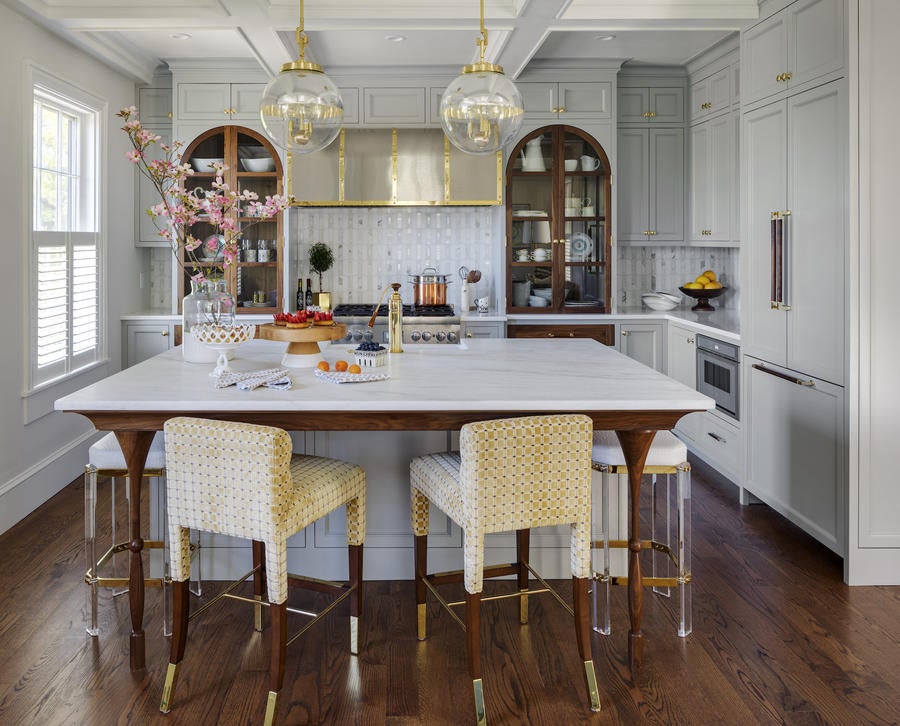
What does everyone on your team do, and how did you build out the business?
We’re small, and we all wear many hats. I think it’s important that everybody has a sense of what’s going on within all aspects of the project, but the only way to really be efficient and get things done is to divide and conquer, so we try to strike a balance between [the two]. Our newest hire, Jenny, comes with a strong architectural background, which we’ve realized is a new skill set that we really need within the business. And then Sarah—I call her our VP of operations, because she keeps all the projects running smoothly. She does all our orders and installations. Once the client signs off on the invoice, she takes it through to the delivery and keeps all our calendars organized. She rules the whole place. And then Katie is an interior designer—she has been with us for a while, and she’s very talented. She is my right hand in terms of my design process, so she does all of our presentations and sits in on client meetings. I’m really lucky with my team.
Where are you the most hands on with each project, and how have you defined your role as the firm has grown?
I think the design is the most important aspect. In the end, it really is all about our portfolio and our imagery—that is our calling card to the world—so I oversee all the design. I pick out every fabric, every rug. Even if it’s a smaller project and Katie is working on it, she runs everything by me—nothing really leaves the office without my stamp of approval. That being said, I’ve realized over time that that’s where I need to concentrate my efforts, so there are other places where, even as a complete control freak, I have learned to let go.
That’s so hard.
It really is. But when I think back to when I was working out of my spare bedroom, when I was the one who did all the design, in addition to meeting with all the vendors, doing all the ordering, opening the UPS boxes, and running around delivering things to clients ... Now, I’m able to have a really strong team with me that helps me do all those things.
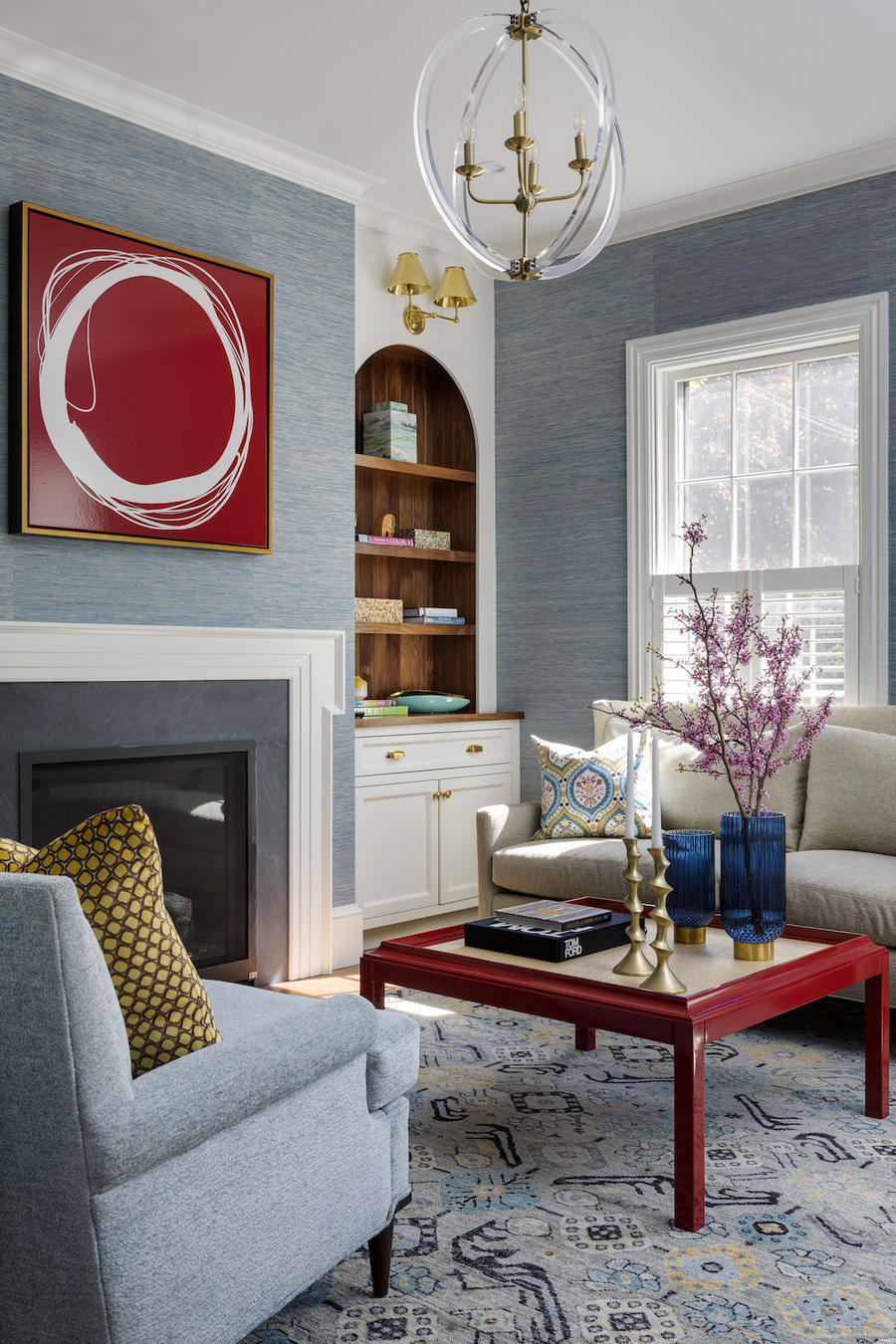
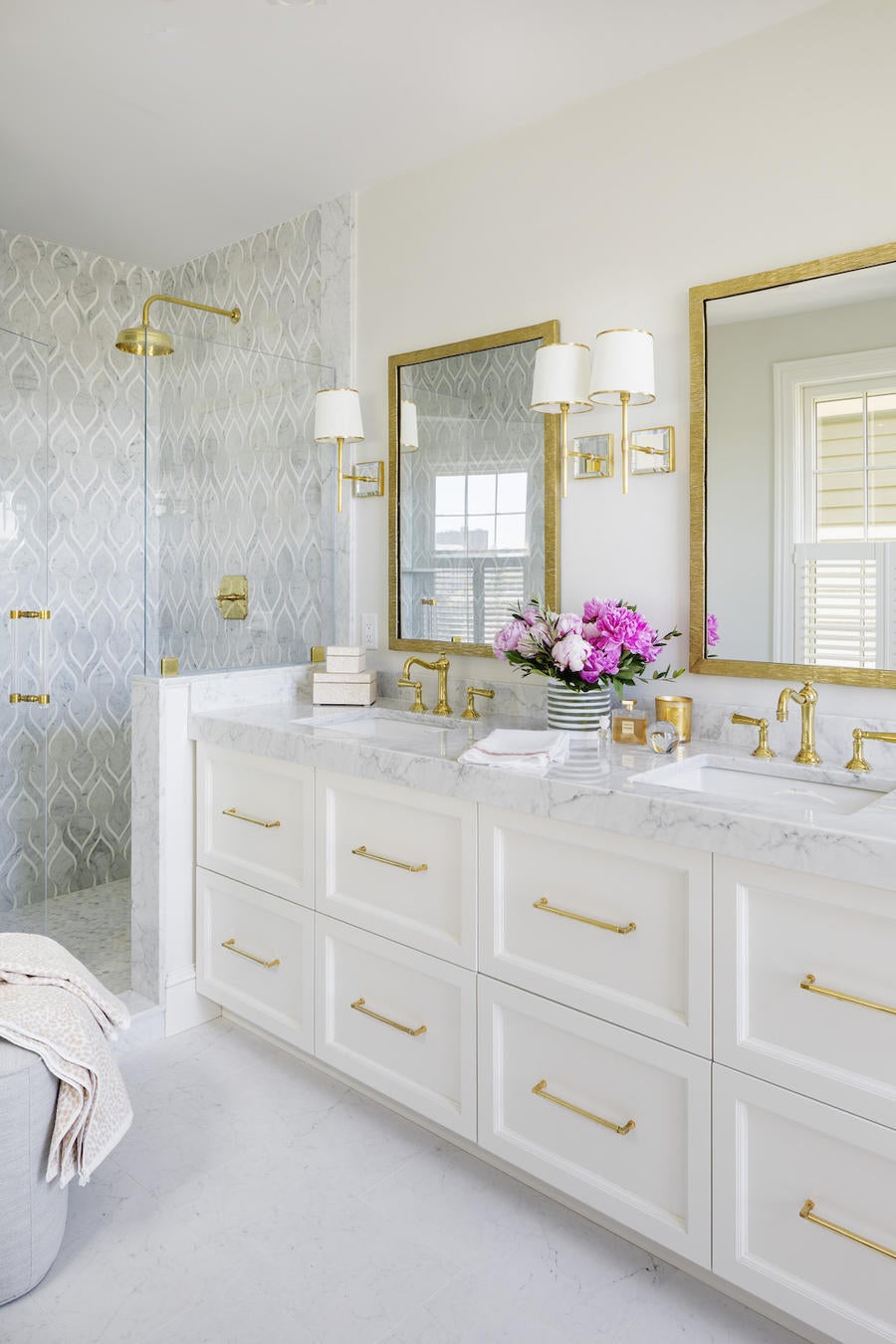
What do you look for when you hire?
I always say I’m a terrible interviewer, so what I’ve learned to do is do the interview, and if I feel like it’s a suitable candidate, I’ll have my team interview those people as well. They’re a little bit better at vetting than I am.
Are there certain qualities you are looking for?
I think the most important thing is, you want the person to have the background and experience to be able to start and learn on their feet. That is super important because we’re a small team and we’re very busy. It’s not like Eastman Kodak, where you’re going to attend training for six weeks—you’re going to start on day one. It’s also important that that person feels comfortable, and that it’s a good fit with my other team members. As much as we’re busy and serious about design, I like the office to have a relaxed approach. We work really, really hard, but at the same time, it’s important to have fun. We go to lunch, have a fun Christmas party, I try to take some of the team to High Point, we do field trips to the Kips Bay Show House in New York. I want it to be an enjoyable experience, and I think my team responds to that. We are a nice happy family.
Tell me about Newport—the types of clients and projects you have.
It’s a somewhat cosmopolitan city within Rhode Island. I live in Matunuck, which is very much a beach community, so when I do cross that bridge into Newport, I have a hint of what it used to feel like going into New York—on a very small scale!
Many clients are from out of state. I’d say 90 percent of our portfolio are summer houses or second or third homes from people who live [out of state], which makes it really interesting. We’ve had people from D.C., California, Atlanta, New York and New Jersey, so we do a lot remotely. Really, we weren’t that affected by COVID, because so much of our business was already via UPS and the phone.
We did a project up in Chatham, Massachusetts, on the Cape, and the client subsequently wanted us to do their place in D.C., so we do a lot of business that way and we’re happy to go anyplace a client is interested in having us.
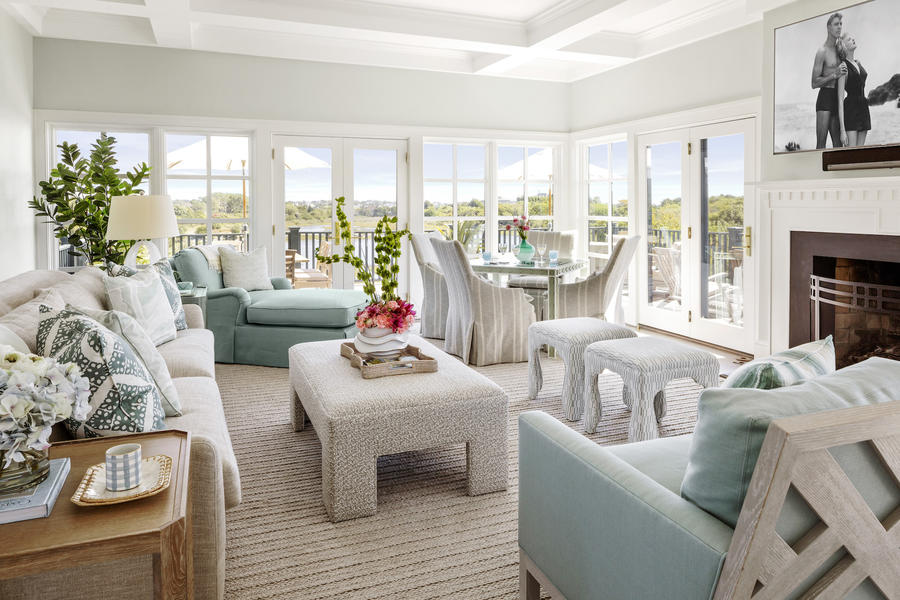
Is there something different about working primarily on second or third homes?
You’d better get it done by Memorial Day!
Because they’ll be there!
Exactly. I always say to clients, it should be a different feel from your primary residence. This is a vacation home, so you’re going to come to relax and entertain with friends and family. You’re going to have dogs and cats and sandy feet, so you want it to be a little bit more relaxed. We tend to use more durable fabrics and rugs for a no-stress life at your second home.
So you were already doing remote presentations with clients before everyone else learned about Zoom?
Yes! If the client can’t make it to the office, a lot of the time we’ll go see them. So many of these projects are new construction or under construction, so we don’t necessarily meet at the job site to do the first presentation. But [if we can’t be together], we’ll put together a binder that has all the selections for each room, where that piece is going, and there will be a subsequent fabric choice that’s labeled, and a rug choice that’s labeled. It’s a pretty big package.
Then we will do a FaceTime or videoconference, paging through that binder together. It’s a nice process that really works, and the clients love it. I have one client that was like, “Oh, my God, this binder, I feel like it’s a Christmas present. I wish I could just snap my fingers and it would all come true.” And obviously we work within budgets and all that, but we did a presentation another time and the client said, “I’ll take the binder! How much?”
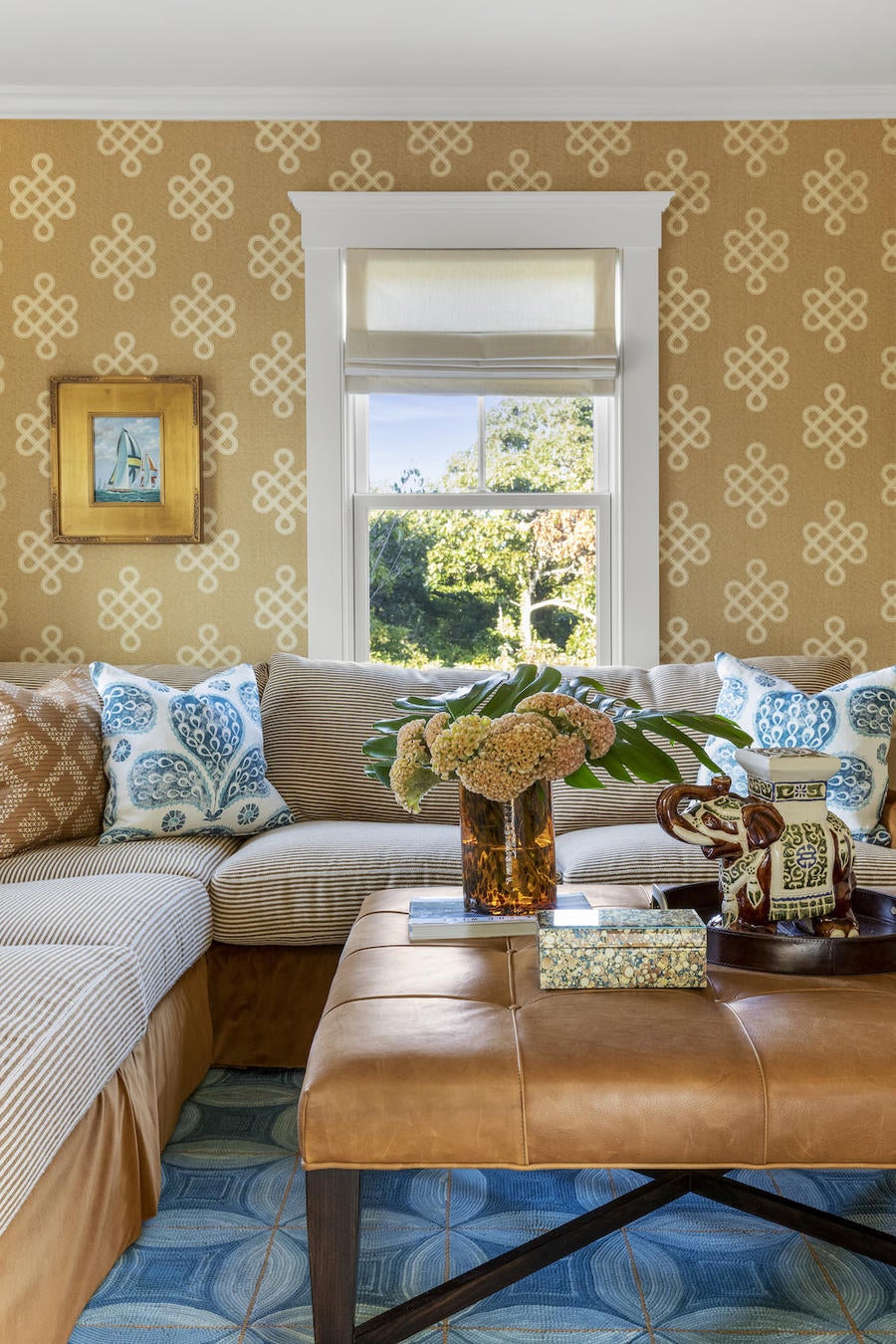

Where do you shop for your projects?
We’ve set ourselves up as a retail store in addition to being a design firm, so the advantage is that we deal directly with the manufacturers in High Point and California—we don’t have to go through the design center for all our furniture purchases. For fabrics, we go through all the showrooms in Boston, and I find a lot of specialty vendors on Instagram—especially some of the artists that we work with.
How does the retail side complement your business?
It’s a small retail operation in front of our office. We are open 9 to 5, and closed on Sundays. The summer season in Newport is the hot time—that’s when all of the tourists run into town—but it gets slow in the winter. Katie handles all the retail clients. We’ll have people that come in for decorative accessories, but we also tend to get people who turn into clients, so that’s really nice.
How long have you had the studio?
When we moved to Newport four years ago, I basically had a glorified window—that’s what attracted people in. Now we have a space that has actual furniture in it.
Is the value in the retail sales, or is it the lead generation, or just having that direct manufacturer relationship?
You have to approach all those different aspects, because you’re never going to get new business just from one avenue. So setting ourselves up as a retailer has certainly helped in terms of our price points—and also our vendor relationships and getting projects completed when they are due. It’s also nice to share our Digs aesthetic with people that don’t necessarily need to do a whole house. They want some fun pillows or a cute little rug. I like being able to have that offering to people in the neighborhood. Luckily, we don’t rely on that retail side [financially], but I love people coming into the shop. We share our story and what we’re all about, and sometimes they end up becoming clients.

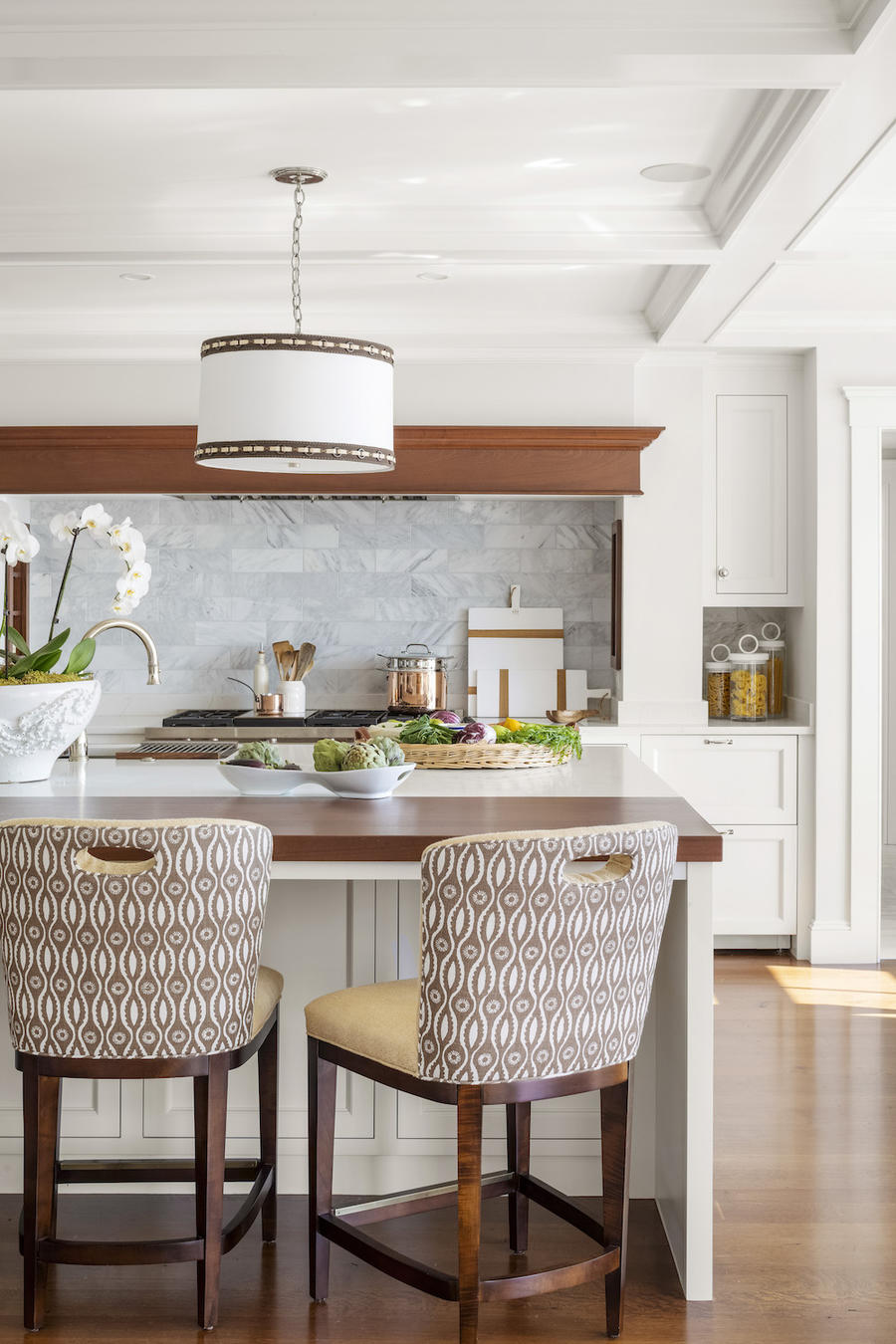
There’s something magical about the idea of someone who comes in to shop but ultimately becomes a client.
It really is. We one time had someone come in with her daughter and they started talking about these chairs they really admired. I was there and started helping them; we ended up selling them the chairs and helping them with a few rugs, and I gave them my card and said, “If you ever want us to pop over and help you … ” We ended up doing almost the entire house—and then their daughter came to work for us! That’s Sarah, our operations person. I always tell her, “I knew you were perfect for Digs when you showed up at the client meeting with your clipboard.”
You talked about how it gets really quiet in the winter—how do you manage your workflow in such a seasonal environment?
When we started out, it was very seasonal. Now it’s less so because the projects are bigger and there are longer lead times. We’re finishing up ordering right now for projects that will install next spring, so we have a pretty large pipeline of projects—that’s basically what got us through COVID. And then there’s always different, smaller, specialty projects too, weaving throughout the whole year. As I say to my husband all the time: “Be careful what you wish for.” I don’t think I can go on vacation ever again.
How many projects do you typically have?
I don’t even know if I can add them all up. We have a whiteboard that has everybody’s projects, and there are the core 10 or so projects—right now, we have several historic renovations in Newport, several summer homes on the Cape and in the Newport area, and just had a referral from a client for a brownstone in Boston, which was such a breath of fresh air. We just got that ordered and are doing some light renovation, but I can’t wait for that install—it’s super chic. So much of our projects tend to be coastal, with sisals and white and light fabrics. But [for the Boston project], we were doing gorgeous Tibetan rugs and velvets and leather and chenille. It was exciting.
So those are the main projects that we’re working on, but I also love doing kitchens, so I started doing this tailor-made kitchen program for people who don’t need an entire house done—maybe they don’t even need any decorating—but their kitchen is dated. Maybe it’s from the ’80s or early ’90s, and they just need a new kitchen. Especially here in Rhode Island, I felt like there wasn’t really a great spot for those people to get a custom kitchen, so we’ve started that offering and it’s been really well-received.
How do people find you for that, specifically?
We get a lot of business on Instagram. We have a lot of referrals, whether it’s from another client or an architect or a builder. We have a few contractors that, if they get a project, they bring us on as the designer. They’re people we love working with, and we try to make their lives easier by helping the client pick all the things that need to be installed. And then in addition, we’ll do the design and both go in on the photo shoot, and then hopefully we get published. So we get a lot of referrals that way. We also do some advertising, but not much.
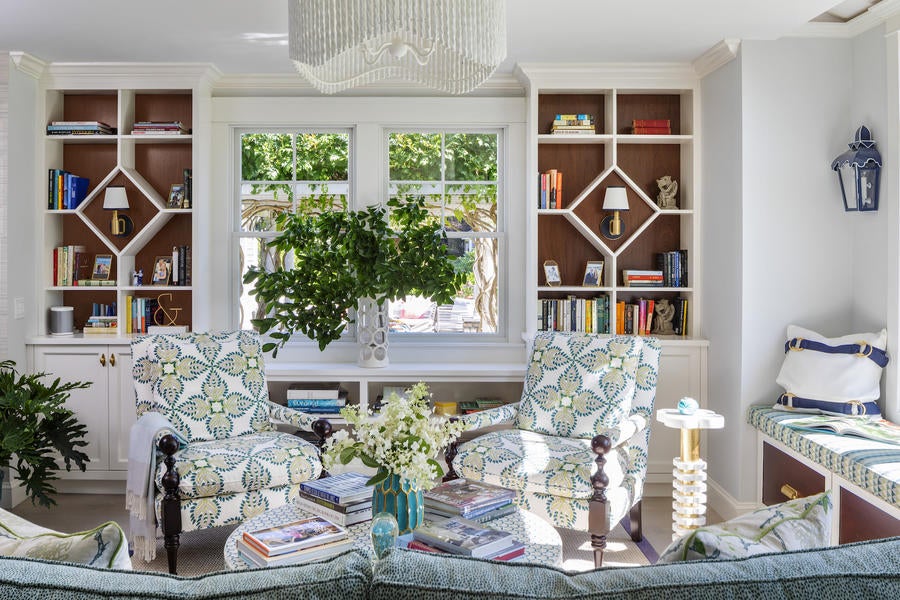
When you look ahead, where do you see opportunity to grow?
I think what we’ve realized, especially during COVID, is we really can be everywhere. We’ve made this strong foothold in Chatham on the Cape—we’ve had some clients, some contractor referrals, and we now have a lot of business up there; now, we’re sort of growing in the same way in Fairfield County [in Connecticut], and in the New York area as well. I’m a couple hours away from those projects, obviously, so I’ve recently hired a dedicated assistant in Connecticut who will be able to be over to a project at the drop of a hat. What I’ve realized is you really can grow by just expanding into new markets.
What is the biggest challenge you see ahead for the firm?
We might be growing out of our space. We moved in there only two and half years ago and did a major build-out, so do I try to make that work? Or if I need to hire more people, do I close the retail and turn that into offices? That might be happening in the future.
You’ve been published nationally recently. What role did that have on the business?
We have referrals, we have the shop—and we have media, which I do think plays a really important role in developing our business and bringing in new clients. I mean, if anyone would’ve told me that I was going to be in House Beautiful or Traditional Home, I would’ve said, “No way.” And it’s not only the prestige of being selected for a national publication—which I feel is important to us as a firm, and has led to more and better projects—it’s also the social media exposure. That’s exploded all of the sudden; about half of the calls we get about new projects now come from Instagram.
Has that changed the way you approach social media?
We’ve made a conscious choice to invest in our marketing and branding, and I think that’s really paid off. In general, I have made a choice over the years to invest in Digs—in my team, my branding, my photography and my location—even when that meant holding back my own paycheck. I’ve always had the same graphic designer, and then a few years ago, we ended up hiring a contractor to do our marketing and social media. She has worked hard on establishing and refining the Digs brand. We recently redid our logo and website, and I think it’s very important to invest in that, because that’s our calling card to clients—and also vendors.
I knew that it was important to invest in the look and feel of the brand, but I didn’t know just how important it was until we dove into it. When I thought about investing in that—it’s expensive, and Instagram wasn’t as huge as it is now, but I’m really glad I made the effort. Plus, when we were doing it internally, marketing, social media and email blasts were always the things that fell to the bottom of the list and never ended up getting done. Having a dedicated person doing that now is so much more efficient.
I’m a little bit old-school about it, though, in that I like separation of church and state. I have my own personal Instagram, where I post pictures of my family and all that, but I try to keep the Digs Instagram just about Digs. It’s important to me to keep a bit of the privacy and the professionalism—making it all about our portfolio. Though I’d probably have more followers if I made it more personal!
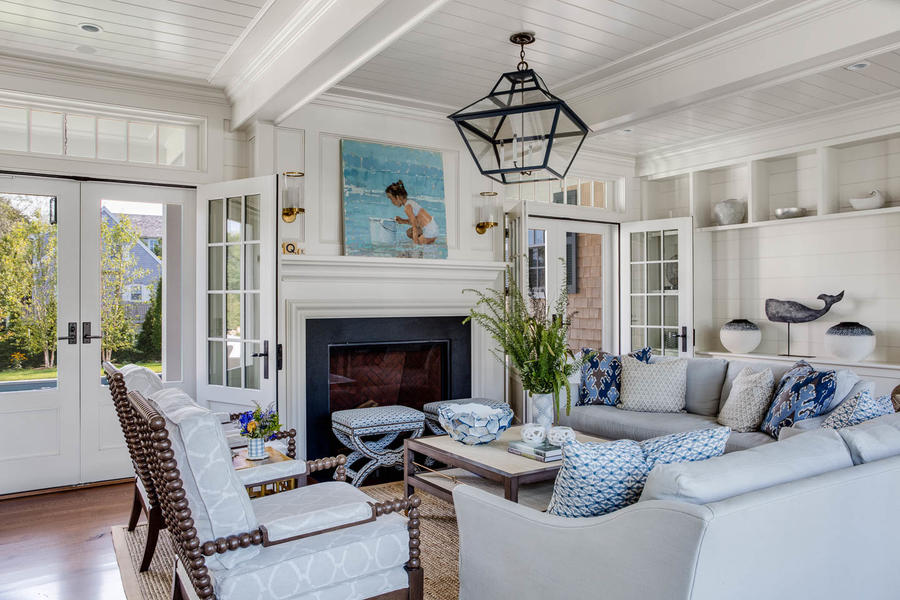
How do you describe your aesthetic? What is it people are coming to the firm for?
I think we have our own Digs aesthetic. The one thing I like about our look is that it’s never boilerplate. I tell clients all the time, “Once I’ve chosen this fabric for you, I’m never using it again.” And that’s pretty much every element in the design. I want the client to feel like it’s their own design, their own look. People will show me a photo of a past project and say, “I want this room.” Well, I’m sorry, but I’m never going to copy what I did there. I want it to be fresh and different, but still have the underlying Digs look.
How do clients respond when you tell them that they’re the only one you’ve ever used that material for?
They like it! I want to do the work, you know? I don’t want to be putting the same light fixtures in every project. Once we’ve used it, I’ve already crossed it off my list—I need to find something new. That’s why it’s so important to go to Paris and High Point, to see what’s coming, what’s fresh, what’s new, what vendors are offering. That’s such an important part of our business, is finding what’s new.
What keeps you inspired right now?
I have a whole coffee table filled with books, and on Saturday morning I always end up thumbing through them for ideas and inspiration as my husband and I have our coffee. [Jacksonville, Florida–based architect and designer] James Howard wrote the book Atmosphere, and we went to his book signing. Somebody asked him, “What is your favorite project?” He replied, “The next one!” I think people with a creative mindset, that’s what always fuels you. You thrive on that. Sometimes I’ll leave a [preliminary meeting] and in my mind I’m already designing—I’ll spend my whole night designing the space in my head and I haven’t even sent them a contract yet! That’s how my mind works.
I’m also looking forward to traveling again. We decided to pass on High Point this fall, but luckily we attended High Point Market and [the shows in] Paris last year. Nothing can replace connecting with vendors and showrooms in person—and my team also needs a field trip!
To learn more about Jocelyn Chiappone, visit her website or find her on Instagram.















